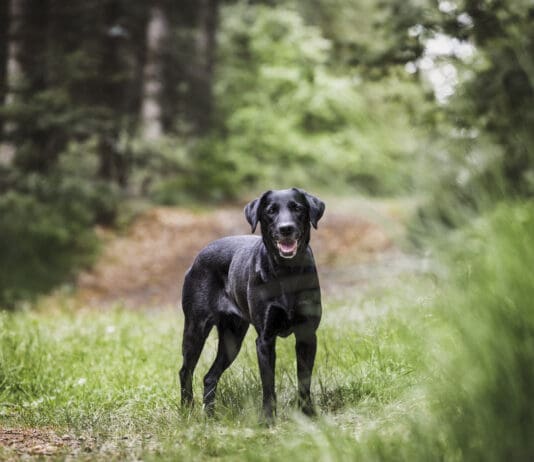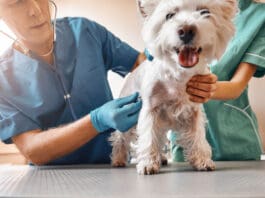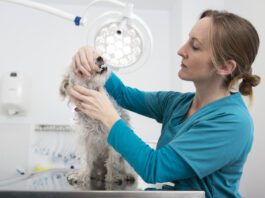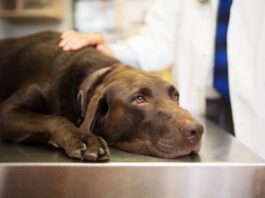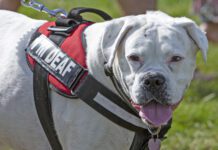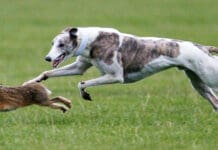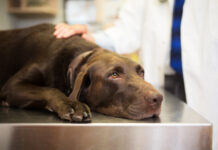Signs of Pancreatitis in Dogs
Any time you see “-itis” at the tail end of a word, it means inflammation of whatever it comes after. Dermatitis is inflammation of the skin. Enteritis is inflammation of the intestines. Hepatitis is inflammation of the liver. Pancreatitis is inflammation of the pancreas.
Why Your Dog is Licking Their Back Near the Tail
If your dog keeps licking their back near the tail it indicates discomfort due to allergies, fleas, hot spots or other issue to investigate.
How Long Can Parvo Last in the Environment?
The parvo virus can live on any surface for weeks to months, and it is easy for people to unwittingly spread parvo virus.
Hookworm in Dogs
Hookworm in dogs is a nasty parasite that can coexist with an adult dog for quite sometime, and spread. Recognizing the signs of hookworm infection is the best way to protect your dog, and other dogs too.
Do They Make Hearing Aids for Dogs?
Hearing aids for dogs are very expensive. custom fit, and require frequent visits to check both fit and settings. Dog vibration collars provide a more affordable and effective way for owners to communicate with their dogs.
Identifying Worms in Dog Poop
Internal parasites or worms are of great concern to both canines and their people. In some cases, the parasites are zoonotic (meaning humans can get them, too).
Diagnosing and Treatment Options for Symmetrical Lupoid Onychodystrophy or SLO
Dog nails aren’t supposed to fall off, thought first-time dog owner Terrie Huberman some 18 months ago. That’s when she first realized that finding one of her Pug-Poodle mix’s nails on the floor of her Sherman Oaks, California, apartment wasn’t an isolated incident. It all started when, after coming in from a walk, Terrie picked up what would turn out to be the keratin shell from one of Bonzo’s claws. At the time she thought it was something he’d tracked in from outside. Only later did she learn the shell was a telltale sign of Symmetrical Lupoid Onychodystrophy, SLO for short.
Canine Diabetes, A Common Yet Serious Problem
Diabetes is a common and serious problem in pets. Formally known as diabetes mellitus (the sweet sickness), it’s a disorder of the pancreas gland. The pancreas produces a hormone called insulin, whose purpose is to drive nutrients, specifically glucose, or blood sugar, into the cells. It’s the body’s most important fuel molecule. Good management is the key to longevity for diabetic dogs.
Managing Idiopathic Epilepsy in Dogs
Idiopathic epilepsy affects young dogs between the ages of six months and six years. As the name implies, the cause of idiopathic epilepsy is unknown. It is a diagnosis of exclusion, meaning that other causes of seizures must be ruled out before making this diagnosis.
Symptoms of Dog Hypothermia
Although hypothermia is usually a cold weather problem. Swimming in cold water, or wet and chill due to rainy weather can also cause hypothermia in dogs.
Symptoms of Heartworm
Heartworm is a deadly parasite spread by the bite of a mosquito. The symptoms of heartworm becoming increasingly severe as the damage progresses. This damage is not fully reversible making prevention or early treatment critical.
Deworming Products and Parasite Control for Dogs
Manufacturers of deworming products have gone out of their way to let us know that, left unchecked, these pesky parasites can plague dogs that are in poor health, rob them of nutrition, attack vital organs, and cause unthriftyness, illness, and even death. If a dog's health is poor and he is hosting an uncontested parasite population, all sorts of bad things can happen. It is important to protect our dogs from parasites, but as it turns out, protection largely follows as a result of building the dog's overall health. Toxic dewormers may be unnecessary to dislodge what few worms a strong and healthy animal might have.


